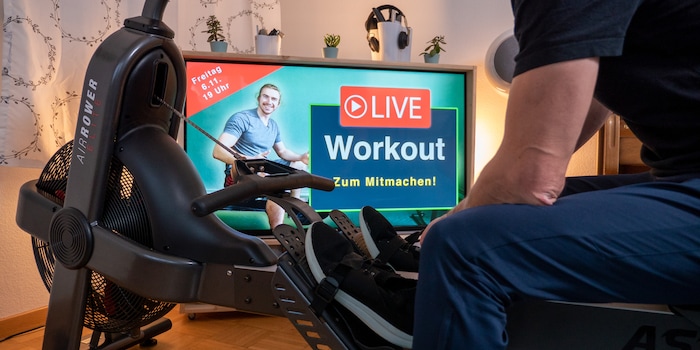
Guide
Training on the Eisenhorn: 5 minutes all in
by Michael Restin

Because training at home is monotonous, I take to the oars on rower Fabian's online galley. The former competitive athlete coaches online and explains to me on the phone what is important when rowing.
If you were to pile up all the fitness equipment gathering dust in basements and guest rooms, the Eiffel Tower would be a toothpick in comparison. The memorial to shattered fitness dreams made up of cycle ergometers, treadmills and rowing trainers would be gigantic. What can I do to keep going? Find someone who will give me a good kick up the arse. That's how Fabian came about.
You're all about healthy rowing. What is important when it comes to the movement?Body tension is the most important factor in eliminating errors. Many people sit on the machine like a wet sack and roll back and forth a bit. Body tension, body tension, body tension! To row healthily and without injury, it is important to make yourself tall. Assume a proud position. This automatically gives you body tension.
What questions do you get asked most often?
Which rowing machine should I use? How often and for how long should I train? That's very unspecific. Many people don't realise why they're doing it at the beginning. If someone wants to lose weight and knows their time budget, this is easier to answer. I always have to ask counter-questions first.
If you have any questions for Fabian, just write them in the comments. And if you don't want to miss anything, you can follow me as an author in my profile.
Simple writer and dad of two who likes to be on the move, wading through everyday family life. Juggling several balls, I'll occasionally drop one. It could be a ball, or a remark. Or both.
Practical solutions for everyday problems with technology, household hacks and much more.
Show allI haven't been to the gym since March. There were times when I missed this opportunity, but at the moment it's working for me. On the one hand, it's because I can test sports equipment at home. And secondly because of Fabian from Ruderathlet.de. I first moved in with the AirRower Elite. A studio-quality rowing machine on which I can scrub kilometres for weeks for a review.
A great thing, actually. Nevertheless, I had a crisis of purpose because looking at my pace, split times and calories burnt in the evening after a day of working from home is only partially satisfying. I'm not frantically chasing personal best times, I'm looking for a balance. Even though the rowing machine has established itself in the competition and Crossfit scene, most dry rowers are probably like me. Health and relaxed training take centre stage.
There are two key points: the right technique and the motivation to keep at it. It's not difficult to train regularly at first. Then the enthusiasm fades and fate takes its course. Our colleague Hunziker tried it out a few years ago and searched for the ideal fitness equipment and ended up rowing. The end of the story...


I end up at the channel of Ruderathlet.de, run by Fabian Kliche. On his website there is endless information, I read through the ultimate checklist and end up on the free crash course. The man becomes a regular in my mailbox with his newsletter and makes sure I follow through with the training.
"You may have already realised that I'm quite good at talking," he says on the phone with a laugh. A quality that is particularly evident in the live workouts. They are entertaining and well structured. I stick with them because I get the feeling that Fabian is having fun. "It's good for me when I don't have to play a role in my videos, but can talk freely," says the Berliner. Between 80 and 130 participants from Germany, Austria and Switzerland are at the start when he goes on air in the early evening, telling anecdotes during the warm-up, announcing intervals and chatting after the cool down.
I pull myself together later and row after the children have fallen asleep. Although I'm not there live, the virtual company motivates me. It helps me to overcome my inner couch potato. Living rooms and fitness centres of all countries, unite. "It's like being on a Roman galley," says Fabian. "My Latin teacher always called me remex. That means rowing servant." He sets the pace in his Berlin flat share, I follow suit and my training becomes more varied.
Sometimes the focus is on technique, sometimes the "Fuego" workout gets me pumped. I enjoy the mixture of training and motivational slogans. This is a relatively new offering: "During the first lockdown, I thought: a bit of sport is good for people, so I regularly do something on YouTube. Something nice has developed from that. If you stay with Ruderathlet afterwards - great. If you do your own thing - great too." However you train, the important thing is that you do it right.
How did you become a rowing coach, Fabian?
Fabian Kliche, Ruderathlet.de: I started rowing at the age of ten and did competitive rowing for years. I ended up training every day, competing in German championships and a few international regattas. My videos were a bit of fun at first. I wanted to post them in individual Facebook groups to show the right technique. I realised in the gym that many people couldn't do it. That then took on a life of its own.
Many beginners struggle with the movement sequence.
Rowing is not an intuitive sport, but a black box for beginners. Running is different. Coordination is therefore definitely the next important point. When you have finished a rowing stroke, the handle is on your body and your legs are stretched. First, the hands go out, then the upper body tilts from the 11 o'clock to the 1 o'clock position and then you roll. These are the basics. If you neglect them, the result is a lot of postural problems.
I've been rowing for a long time, but I've never consciously trained the stroke structure and dissected the movement into individual parts. Especially when preparing the pull phase, I realised that I could still get a lot out of it.
I'm delighted! It's great when the participants have exactly the experience in the workout that I had planned. The core, abdomen and back transfer the power to the handle. If you're not completely stable, there are energy gaps. Where I used to say: "Keep body tension!", today I talk about pretensioning, clamping and stepping down. You learn what works better for people.
Another realisation was that I can also power myself out at a low stroke rate.
Whether you ride at a stroke rate of 20 with 20, 60 or 100 per cent power input is as different as night and day. You need body awareness for that. Whether you're learning something intellectual or a movement, the nervous system always has to be developed first. That's why it's important to first find a rough basic orientation in order to have a counterpart to relaxed jogging. Everyone can judge themselves when running and you also need an anchor point for rowing. At the beginning, you don't know what stroke rate 20 with a lot or little effort means. You have to find your frame first.
How do I best approach this?
Regularity is very important for learning. It takes two to three weeks for intermuscular coordination to improve. Like an orchestra that plays better together. You should make a fixed appointment two to three times a week. Practise the stroke structure first and then continue rowing for another five to ten minutes, concentrating only on the movement. It's better to train a little more often than once a week for a long time. It's easy to integrate into your daily routine and everyone has 20 to 30 minutes. You don't have to exhaust yourself, but you should go out feeling good. If you can manage that, you can set yourself new goals.
You also ask questions during the live workouts. I was always super relaxed afterwards, although sometimes the training could have been more intensive.
The exchange in the chatbox is really nice and a great source of motivation for me. I find out straight away how a workout is received and how strenuous it is perceived to be. It's more about feeling good afterwards. The focus is on enjoying the exercise, I'm not aiming for a new 2000 metre best time. There's no point in having a cool fitness programme that doesn't fit in with people's everyday lives.
That's probably what appealed to me about Fabian's channel. He picks me up in the middle of everyday life, works on himself and his programme and occasionally struggles with small problems himself: When it rains in Berlin, the internet connection sometimes hangs while I stare nervously at my iPad in the middle of a workout. But the guy is authentic and motivating. After a technical training session, I once again picked up something new: Back pain. Find out how it came about and how you can prevent similar problems in part two.